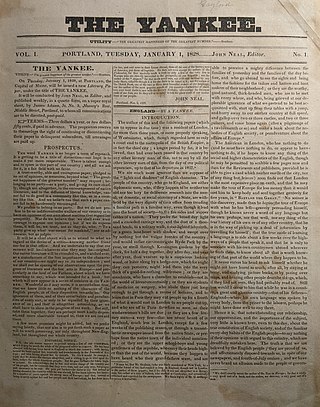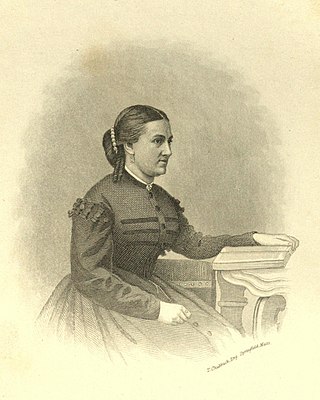Related Research Articles

Harriet Elisabeth Beecher Stowe was an American author and abolitionist. She came from the religious Beecher family and became best known for her novel Uncle Tom's Cabin (1852), which depicts the harsh conditions experienced by enslaved African Americans. The book reached an audience of millions as a novel and play, and became influential in the United States and in Great Britain, energizing anti-slavery forces in the American North, while provoking widespread anger in the South. Stowe wrote 30 books, including novels, three travel memoirs, and collections of articles and letters. She was influential both for her writings and for her public stances and debates on social issues of the day.

Sarah Josepha Buell Hale was an American writer, activist, and editor of Godey's Lady's Book. She was the author of the nursery rhyme "Mary Had a Little Lamb". Hale famously campaigned for the creation of the American holiday known as Thanksgiving, and for the completion of the Bunker Hill Monument.

Godey's Lady's Book, alternatively known as Godey's Magazine and Lady's Book, was an American women's magazine that was published in Philadelphia from 1830 to 1878. It was the most widely circulated magazine in the period before the Civil War. Its circulation rose from 70,000 in the 1840s to 150,000 in 1860. In the 1860s Godey's considered itself the "queen of monthlies".
Fanshawe is a novel written by American author Nathaniel Hawthorne. It was his first published work, which he published anonymously in 1828.

Louis Antoine Godey was an American editor and publisher. He was the founder of Godey's Lady's Book in 1837, the first successful American women's fashion magazine.
Nationality words link to articles with information on the nation's poetry or literature.

Ann Sophia Stephens was an American novelist and magazine editor. She was the author of dime novels and is credited as the progenitor of that genre.

A fashion plate is an illustration demonstrating the highlights of fashionable styles of clothing. Traditionally they are rendered through etching, line engraving, or lithograph and then colored by hand. To quote historian James Laver, the best of them tend to "reach a very high degree of aesthetic value."
John Lauris Blake was an American clergyman and bestselling author. He is best known as the author of the General Biographical Dictionary.

Eliza Leslie (1787–1858), frequently referred to as Miss Leslie, was an American author of popular cookbooks during the nineteenth century. She also wrote household management books, etiquette books, novels, short stories and articles for magazines and newspapers.

Arthur's Magazine (1844–1846) was an American literary periodical published in Philadelphia in the 19th century. Edited by Timothy Shay Arthur, it featured work by Edgar A. Poe, J.H. Ingraham, Sarah Josepha Hale, Thomas G. Spear, and others. In May 1846 it was merged into Godey's Lady's Book.

The Bower of Taste (1828–1830) was a periodical edited by Katherine Augusta Ware in Boston, Massachusetts, in the 19th century. Contributors included Albert Pike, Thomas Edwards and Margaret Snow." The bi-weekly magazine ceased in May 1830.

James Reid Lambdin was an American born artist, famous for many of his portraits of U.S. Presidents.

Theron Metcalf was an American attorney and politician from Massachusetts. He was a New England jurist and served as an associate justice of the Massachusetts Supreme Judicial Court.
Anna Maria Wells was a 19th-century poet and a writer of children’s literature. The poet and editor Sarah Josepha Hale wrote that Wells, as a child, had a "passionate love of reading and music," and began to write verses when very young. In 1830, Wells published Poems and Juvenile Sketches, a compilation of her early work, after which she contributed occasionally to various periodicals. Hale opined that "the predominant characteristics of [Wells'] poetry were tenderness of feeling, and simplicity and perspicuity of language." Wells' contemporaries, in addition to Sarah Hale, were Caroline Howard Gilman, Hannah Flagg Gould, Eliza Leslie, Catharine Maria Sedgwick, and Lydia Huntley Sigourney
Emeline Horton Cleveland was an American physician and one of the first women to perform major abdominal or gynecological surgery in the United States. She became one of the first woman physicians associated with a large public hospital in the United States, and she established one of the first nursing assistant training programs in the country.

Harriet Marion Stephens was an American actress and writer. Stephens was born in Maine in 1823 to Reverend John Atwell of the Maine Methodist Conference. She began her career as an actress, appearing as Mrs. Rosalie Somers before taking up writing instead. Her first pieces, such as a eulogy for Edgar Allan Poe published in Godey's Lady's Book in February 1850, appeared in various periodicals. In 1853 she issued Home Scenes and Home Sounds. The novel Hagar, the Martyr appeared in print the following year (1854); a melodrama featuring a Southern heroine whose ambiguous racial identity serves as a point of tension throughout the story. It received favorable reviews. Stephens died in East Hampton, Maine.

The Yankee was one of the first cultural publications in the United States, founded and edited by John Neal (1793–1876), and published in Portland, Maine as a weekly periodical and later converted to a longer, monthly format. Its two-year run concluded at the end of 1829. The magazine is considered unique for its independent journalism at the time.

Bella Zilfa Spencer was an English-born American novelist and early editor of the Saturday Evening Post, She was the first wife of future US Senator George Eliphaz Spencer.

Mary Gardiner Horsford was an American poet and the wife of chemist Eben Norton Horsford.
References
- ↑ Jennifer Nelson (October 1, 2012). Airbrushed Nation: The Lure and Loathing of Women's Magazines. Seal Press. p. 40. ISBN 978-1-58005-463-8 . Retrieved July 28, 2015.
- ↑ Roxanne Hovland; Joyce M. Wolburg; Eric E. Haley (December 18, 2014). Readings in Advertising, Society, and Consumer Culture. Routledge. p. 188. ISBN 978-1-317-46136-4 . Retrieved July 28, 2015.
- ↑ Greenberg, Hope A., Sarah Josepha Hale Biography, Godey's Lady's Book.
- 1 2 Entrikin, Isabelle Webb, Sarah Josepha Hale and Godey's Lady's Book, Philadelphia, 1946.
- ↑ Rose, Anne C. Transcendentalism as a Social Movement, 1830–1850. New Haven, CT: Yale University Press, 1981: 24. ISBN 0-300-02587-4.
- ↑ "Godey's Lady's Book". Accessible Archives. Retrieved 19 June 2015.